Living in a space with limited natural light doesn’t mean you have to give up on your plant parent dreams. Many beautiful houseplants not only tolerate low-light conditions but actually prefer them. These shade-loving plants can transform your dimly lit rooms into green sanctuaries.
What Does “Low Light” Really Mean for Indoor Plants?
Low light doesn’t mean no light at all. Low-light indoor plants still need low light to survive, usually measured at 25-200 foot candles. Think of areas that are 6-10 feet away from windows, north-facing rooms, or spaces where you can read comfortably but the area feels dimmer than other parts of your home.
In their native growing environments, these plants are “understory plants” meaning they grow underneath the branches of larger plants. This natural adaptation makes them perfect for indoor spaces with limited sunlight.
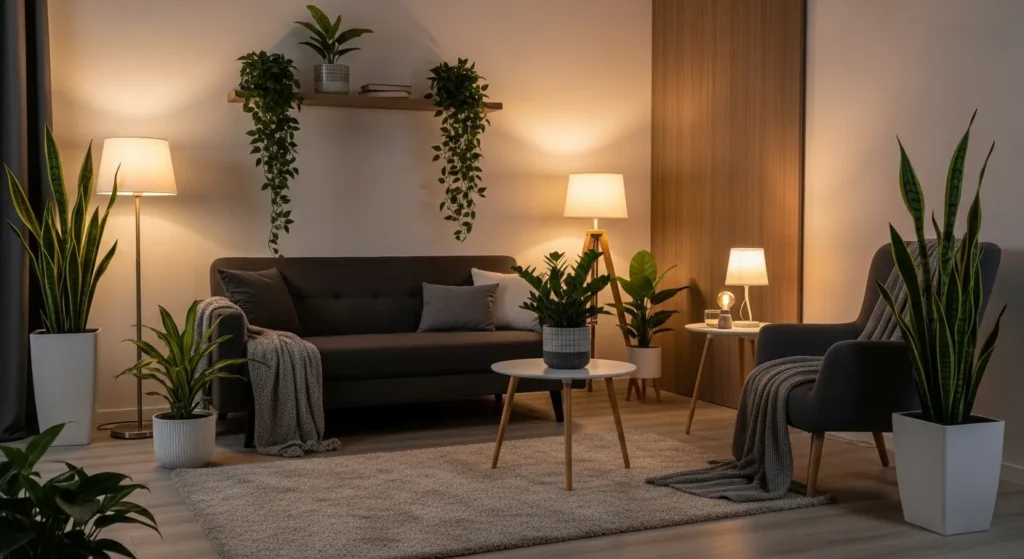
Best Low-Light Plants That Actually Thrive
Easy-Care Champions
ZZ Plant (Zamioculcas zamiifolia) ZZ plant grows well in a dry environment and pushes the low-light limit to its extreme. This African native stores water in its thick stems and glossy leaves, making it nearly indestructible. It grows 2-3 feet tall and requires water only when the soil is completely dry.
Snake Plant (Sansevieria trifasciata) Snake plant performs well in dry spells and handles moderate to low light with ease. Place it about 10 feet from a west or south-facing window. The upright, sword-like leaves add architectural interest to any room.
Cast Iron Plant (Aspidistra elatior) Aspidistra elatior, known as the Cast Iron Plant, is celebrated for its robustness and ability to thrive in low light and neglect. This Chinese native earned its common name for being nearly impossible to kill.
Trailing and Hanging Varieties
Pothos (Epipremnum aureum) Pothos is a low-light lover that makes a good entry point into growing houseplants. Its heart-shaped leaves cascade beautifully from hanging baskets or shelves. Golden pothos features yellow variegation that brightens dark corners.
Philodendron Philodendron is a medium- to low-light houseplant that prefers to be kept dry between waterings. Choose from trailing varieties like heartleaf philodendron or upright types with larger leaves.
Tradescantia Zebrina (Wandering Jew) Tradescantias are pretty in planters or hanging baskets that let their vining stems trail gracefully. The purple and silver striped leaves add color to dim spaces.
Colorful Foliage Plants
Chinese Evergreen (Aglaonema) Aglaonema, or Chinese evergreen, is an easy-to-grow foliage plant that performs well in low to medium light. Varieties come in stunning combinations of green, pink, red, and silver patterns.
Calathea (Prayer Plant) Calathea, including the beloved prayer plant, grow well in medium to low light. Their patterned leaves fold up at night like praying hands. They prefer consistent moisture and humidity.
Rex Begonia Rex begonias are grown for their colorful foliage and thrive in medium to low light. Their leaves display incredible patterns in burgundy, silver, green, and pink.
Palms and Tree-Like Plants
Parlor Palm (Chamaedorea elegans) Parlor palms can adapt to low light conditions or thrive near windows with cool morning sun or late afternoon light. This compact palm brings tropical vibes to any space.
Ponytail Palm (Beaucarnea recurvata) These are some of the easiest tropical plants to grow, happy in low to bright, indirect light and they don’t need much water. The bulbous trunk stores water, making it drought-tolerant.
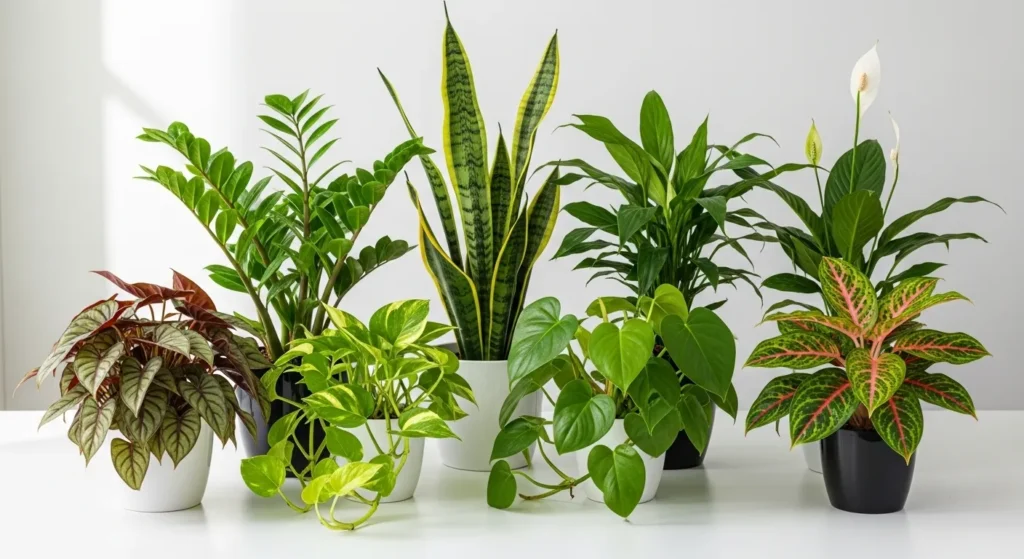
Understanding Light Levels in Your Home
North-Facing Rooms These receive the least direct sunlight throughout the day. Perfect for plants that prefer consistent, gentle light without harsh rays.
East-Facing Rooms Get soft morning light but remain cooler throughout the day. Suitable for plants that need some brightness but not intense afternoon sun.
Rooms Without Windows Can still support plant life with artificial lighting. If your room has no windows, you should leave grow lights on for 12 hours a day.
Areas 6+ Feet from Windows These spots receive reflected and filtered light, perfect for most low-light plants.
Essential Care Tips for Low-Light Plants
Watering Guidelines
In environments with less light, plants grow more slowly and use less water. This means you’ll water less frequently than plants in brighter locations.
- Check soil moisture before watering
- Allow soil to dry between waterings for most varieties
- Use well-draining potting mix to prevent root rot
- Water thoroughly but less often
Soil and Fertilizing
Low-light plants prefer well-draining soil that doesn’t stay soggy. Most commercial potting mixes work well. During growing season (spring and summer), fertilize monthly with diluted houseplant fertilizer. In winter, reduce or stop fertilizing as growth slows.
Common Problems and Solutions
Leggy Growth Low light levels can result in spindly, lanky growth as the plant stretches towards the sun. Move the plant closer to a light source or add artificial lighting.
Yellowing Leaves Usually indicates overwatering, especially common in low-light conditions where plants use less water.
Loss of Variegation Brightly colored and variegated leaves may lose contrast and vibrancy in lower light. Move slightly closer to a light source to maintain leaf patterns.
Best Rooms for Low-Light Plants
Bathrooms
Perfect for humidity-loving plants like staghorn ferns and prayer plants. Staghorn fern requires moderate light but thrives in high humidity locations such as bathrooms.
Bedrooms
Snake plants and ZZ plants work well here, as they release oxygen at night and tolerate the typically lower light levels.
Home Offices
Peperomias can thrive in the fluorescent light of an office or shop space. Consider Chinese evergreens, pothos, or peace lilies for workspace greenery.
Hallways and Entryways
Cast iron plants and snake plants can handle the lower light and occasional neglect in these transitional spaces.
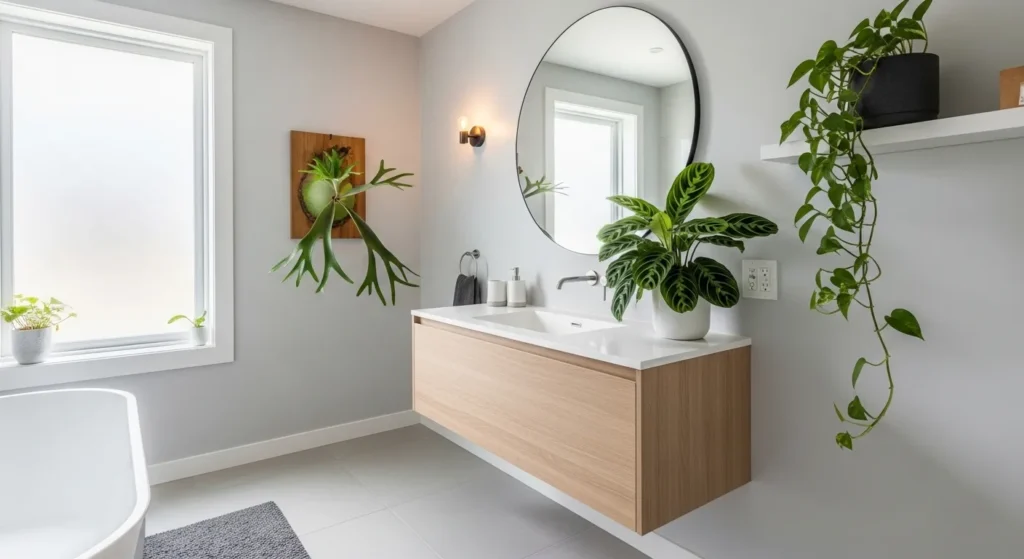
Flowering Low-Light Plants
Peace Lily (Spathiphyllum)
Peace lily prefers moderate to low light and consistently moist soil. It reblooms several times a year, even with low-light conditions. The white flowers appear several times yearly, adding elegance to dim corners.
Anthurium
Anthurium bloom in red, white or pink and rebloom well in medium to low light. These heart-shaped flowers last for months and add tropical color to your space.
Bromeliad
Guzmanias prefer low light and can’t take direct sun. Their bright red, orange, yellow, or purple flower clusters create stunning focal points.
Specialty Low-Light Plants
Air Plants and Epiphytes
Staghorn Fern As an epiphytic plant, it requires no soil. Wall-mounting is a popular way to display staghorn fern. These living sculptures add dramatic texture to walls.
Unique Foliage Plants
Nerve Plant (Fittonia) Nerve plants get their common name from the colorful veins on their leaves. These small plants feature intricate white, pink, or red vein patterns on green leaves.
Watermelon Peperomia This variety is named for its leaves, which look like watermelon rinds. The round leaves have green and silver stripes resembling tiny watermelons.
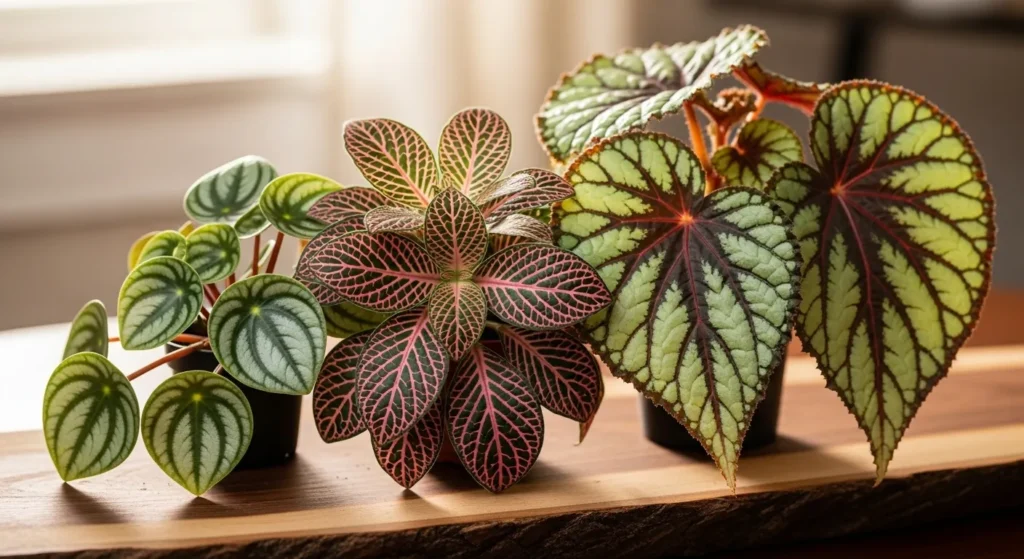
Troubleshooting Low-Light Plant Problems
Signs Your Plant Needs More Light
- Stems becoming long and spindly
- Leaves losing color or variegation
- Very slow or no new growth
- Leaning heavily toward light sources
Signs of Too Much Light
- Brown, scorched leaf edges
- Leaves becoming pale or washed out
- Soil drying out too quickly
Improving Growing Conditions
Add Artificial Light LED grow lights can supplement natural light. Position them 6-12 inches above plants and run for 12-14 hours daily.
Increase Humidity Many low-light plants appreciate higher humidity. Use pebble trays, humidifiers, or group plants together.
Proper Air Circulation Good airflow prevents fungal issues common in low-light, high-humidity conditions.
Monthly Care Calendar for Low-Light Plants
Spring (March-May)
- Resume monthly fertilizing
- Repot if roots are crowded
- Increase watering as growth resumes
Summer (June-August)
- Monitor for pests more frequently
- Maintain consistent watering schedule
- Rotate plants for even growth
Fall (September-November)
- Reduce fertilizing frequency
- Check for drafts from windows
- Begin reducing water as growth slows
Winter (December-February)
- Stop fertilizing most plants
- Water sparingly
- Watch for dry air from heating systems
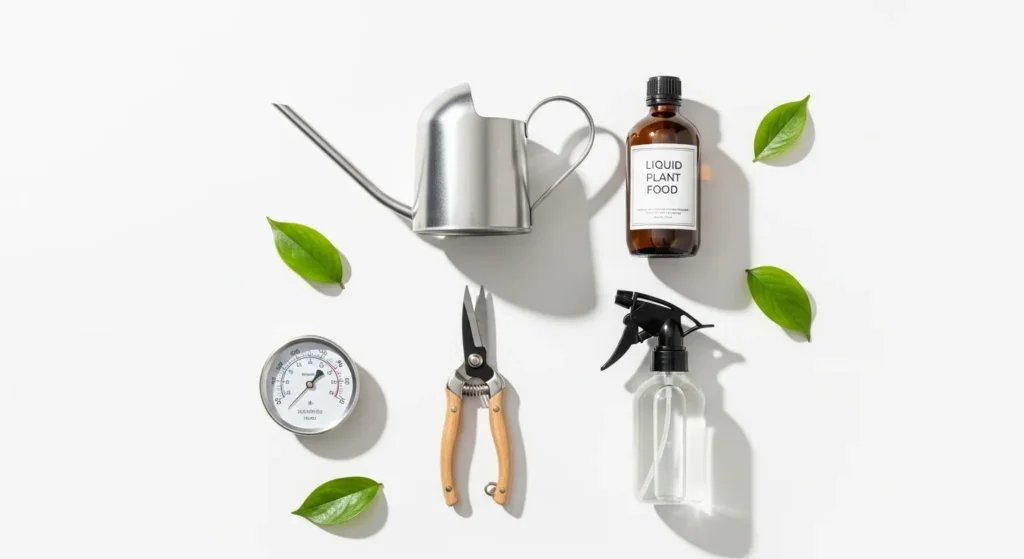
Creating the Perfect Low-Light Plant Display
Layering Heights
Combine tall plants like snake plants with medium plants like Chinese evergreens and trailing plants like pothos for visual interest.
Grouping for Impact
Group plants with similar care needs together. This also creates beneficial microclimates with higher humidity.
Container Selection
Choose pots with drainage holes. Decorative cache pots work well but ensure water doesn’t sit in the bottom.
Budget-Friendly Low-Light Plant Options
Propagation Opportunities
Many low-light plants are easy to propagate:
- Pothos and philodendron root easily in water
- Snake plants can be divided when repotting
- Spider plants produce baby plants on runners
Where to Find Affordable Plants
- Local plant swaps and community groups
- Grocery stores often carry basic varieties
- Online retailers for harder-to-find species
- Friends and neighbors with mature plants
Advanced Tips for Low-Light Success
Seasonal Adjustments
Move plants closer to windows during winter months when daylight hours are shorter. As seasons change, so does the amount of daylight. You will need to move your plant as the sun changes its position to adjust its exposure to the sunlight.
Cleaning for Better Light Absorption
Dust on leaves blocks what little light is available. Wipe leaves monthly with a damp cloth or give plants a gentle shower.
Recognizing Plant Stress
Learn to read your plants’ signals. Dropping leaves, color changes, or unusual growth patterns indicate the need for care adjustments.
Low-Light Plants for Specific Needs
Pet-Safe Options
- Spider plants
- Parlor palms
- Boston ferns
- Prayer plants
Air-Purifying Varieties
- Snake plants
- Peace lilies
- ZZ plants
- Philodendrons
Flowering Options
- Peace lilies
- Anthuriums
- African violets
- Bromeliads
Common Mistakes to Avoid
Overwatering
The number one killer of low-light plants. In environments with less light, plants grow more slowly and use less water.
Wrong Pot Size
Too large pots hold excess moisture. Too small pots restrict root growth.
Ignoring Humidity Needs
Many low-light plants are tropical and appreciate higher humidity than typical indoor levels.
Expecting Fast Growth
Low-light plants grow slowly by nature. Don’t over-fertilize trying to speed up growth.
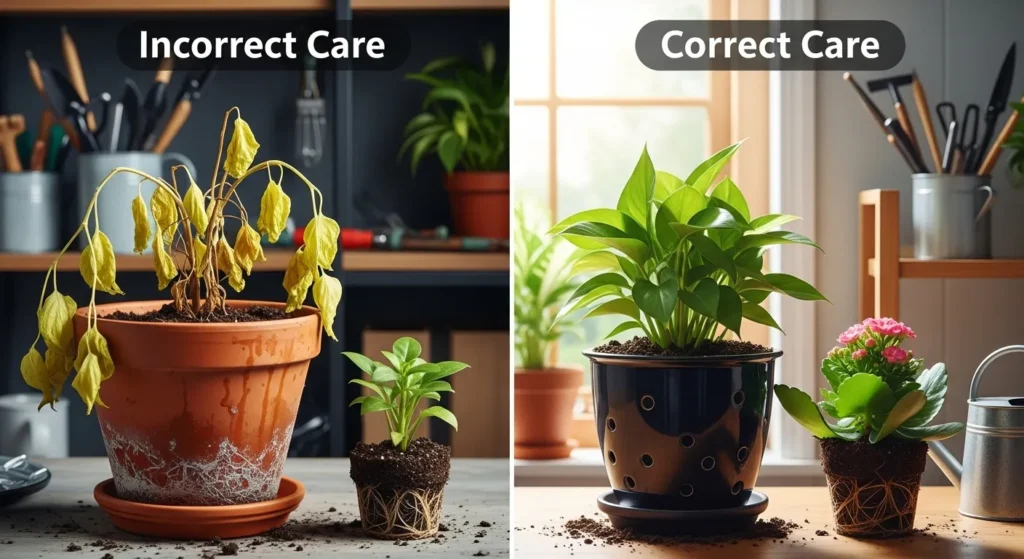
Creating Your Low-Light Plant Collection
Start Small
Begin with 2-3 easy plants like pothos, snake plant, and ZZ plant. Learn their care requirements before expanding your collection.
Consider Your Lifestyle
Choose plants that match your schedule. Frequent travelers should focus on drought-tolerant varieties like snake plants and ZZ plants.
Plan for Growth
Many low-light plants can live for decades with proper care. Consider mature sizes when planning placement.
Seasonal Care Adjustments
Winter Care
Reduce watering frequency as growth slows. Watch for dry air from heating systems. Consider adding humidity through pebble trays or humidifiers.
Summer Care
Even low-light plants may need protection from air conditioning drafts. Maintain consistent moisture during active growing season.
Conclusion
Low-light indoor plants offer the perfect solution for bringing nature indoors regardless of your home’s lighting situation. Start with proven performers like snake plants, ZZ plants, and pothos. Pay attention to your plants’ signals and adjust care accordingly. With proper selection and care, your low-light spaces can become thriving green environments.
Remember that every plant is different, even within the same species. Observe your plants regularly and adjust their care based on their individual responses to your home’s unique conditions.
Looking to improve other areas of your home? Check out our guides on closet organization for small spaces and affordable backyard makeover ideas for more home improvement inspiration.
